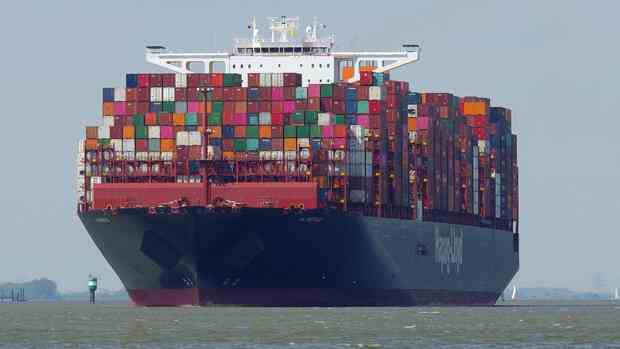Germany’s largest container shipping company benefited from the high freight rates in the past financial year.
(Photo: IMAGO/Markus Tischler)
Dusseldorf In the past financial year, Hapag-Lloyd doubled its operating result to 17.5 billion euros, thereby moving into the top group of German companies. According to the preliminary figures published on Tuesday morning, Germany’s largest shipping company increased its turnover by more than half to 34.5 billion euros in 2022 and was therefore – as was the case with the operating result (EBIT) – slightly above the analysts’ estimates.
Hapag-Lloyd does not intend to announce net profit figures until March 2nd, but analysts are already expecting a record figure of 16.8 billion euros. For comparison: The Dax heavyweight Volkswagen, which turned over eight times as much as Hapag-Lloyd, is expected to report a net profit of 16.6 billion euros for 2022 – and thus probably overtaken by the Hamburg shipping company.
A major reason for Hapag-Lloyd’s extraordinarily high profits are the exorbitant freight rates, which were demanded on the world’s oceans between summer 2021 and spring 2022 in particular. For example, the journey of a 20-foot standard container (TEU) from Shanghai to Northern Europe cost up to 8,000 dollars at that time – five times the usual price. There were also unusual surcharges, for example for the provision of containers or punctual removal.
Freight rates collapsed again after the boom
The price spiral was triggered by numerous bottlenecks in sea transport, which drastically restricted the supply. At the beginning of the corona pandemic, consumers in the USA in particular had increasingly ordered swimming pools, kitchen equipment and DIY items. After all, they wanted to be prepared for possible lockdowns.
The purchases triggered an import boom from the Far East, which is why shipping companies relocated part of their fleets to the Pacific. This in turn caused bottlenecks in Asia-Europe traffic, followed by massive price increases there as well.
The boom is long over. Since peaking in the summer of 2021, average freight rates have plummeted from $5,200 to $1,030, according to the Shanghai Containerized Freight Index (SCFI). But the high tariffs of the past are still having an effect.
subsided
-80
percent
Since the summer of 2021, average freight rates have collapsed from $5,200 to $1,030.
The company said that a significant proportion of customers had signed long-term contracts during the high-price period in order to be prepared for a further increase. The fall in prices on the spot market initially had only a minor impact on the shipping company. However, Hapag-Lloyd’s earnings situation is also likely to deteriorate soon, as the contracts rarely run for more than a year.
Container transport is becoming more expensive
In addition, the costs of the fleet of 252 cargo ships are increasing. “Fuel purchases alone cost 112 dollars per container compared to the previous year,” said Hapag-Lloyd CEO Rolf Habben Jansen shortly before the turn of the year. Together with the increased handling costs in the ports and higher depreciation, the cost of transporting a container has risen by as much as 243 dollars within a year – and thus by 22 percent.
Since the transport volume is hardly growing anymore – for the whole of 2022 it was at 11.8 million TEU at Hapag-Lloyd at the level of the previous year – the listed Hamburg shipping company has been expanding into neighboring sectors for over a year. So you not only acquired a minority share in the deep-sea port Jade-Weser-Port near Wilhelmshaven. At the end of last week, the shipping company also announced that it would take a 35 percent stake in the Indian terminal operator JM Baxi Ports & Logistics.
In addition, the Hamburg-based company agreed to take over the terminal business of the Chilean company SM SAAM, which gives them preferential access to numerous ports in North and South America. In addition, Hapag-Lloyd acquired a 49 percent stake in the Italian Spinelli Group in mid-January. The family business is considered the leading logistics group in Italy. The diversification aims to protect against a further decline in freight rates at sea.
Because there are already signs of an oversupply of cargo ships for the coming years. By the delivery year 2025, ship capacities for 7.3 million standard containers (TEU) are in the order books, which corresponds to 28 percent of the world fleet. For comparison: from 2017 to 2020, the proportion of new orders ranged between just ten and 13 percent of the existing fleet.
The skepticism has long been evident on the stock market. Despite Hapag-Lloyd’s business figures exceeding expectations, their papers were around 2.1 percent below the previous day in the morning. Since peaking in mid-May 2022, the stock has lost more than half of its value.
More: Shipping containers almost as cheap as before Corona.
